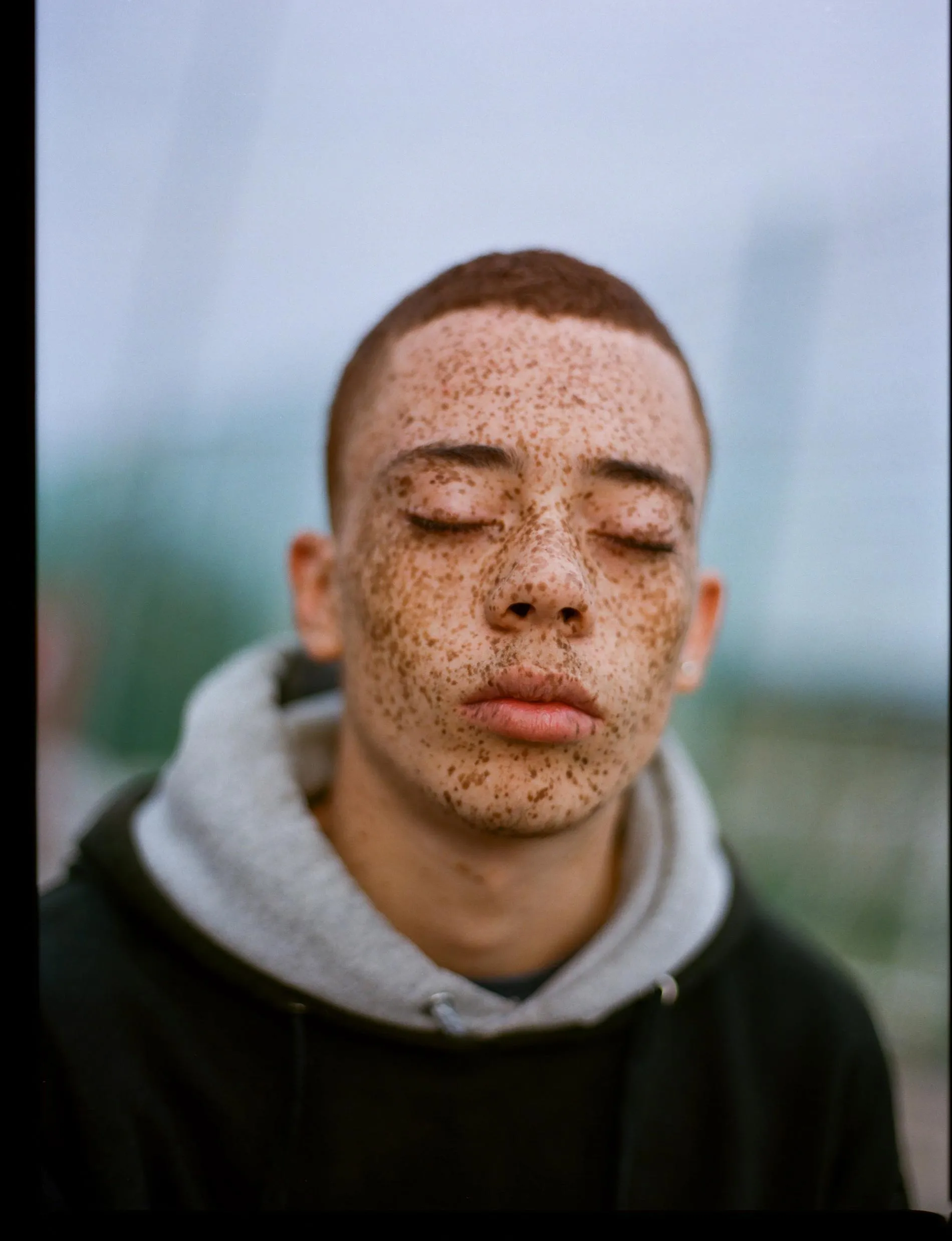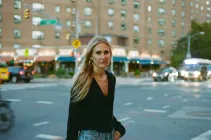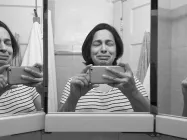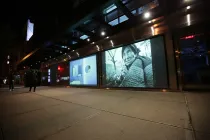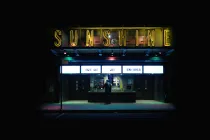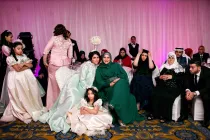As digital photography took over mind and marketshare, film photography would quickly be described as a relic of the past and something only used by older photographers who feared changed or luddites who romanticized the past.
Fast forward a few decades, and film is still here and even experiencing a new popularity as young photographers pick up affordable vintage film cameras and discover the warmth and humanity that film can bring to a images.
During the day, Emerging Analog can be viewed on monitors inside the ICP Museum and during evening hours, images are literally “projected” onto the windows of the ICP Museum; they can be viewed from the sidewalk outside the Museum and are most visible after sunset. Learn more about Projected.
This installment of Projected was co-curated by Steve Carter, social media specialist at Kodak.
About the Artists
Each of the featured photographers is dedicated to shooting film. Below, they share their thoughts on what makes film photography so special.
Aisha Wanjiru Mugo is a 23-year-old Somali-Kenyan self-taught analog photographer currently residing in Cape Town, South Africa. She is currently undertaking her postgraduate studies in migration and African urbanism at the University of Cape Town. Her work is grounded in showcasing the dynamism of African youth, especially womxn and focuses on (re)-claiming agency and reimagining African narratives beyond the Western gaze and expectation.
“Shooting in film, especially in my country Kenya, is considered a thing of the past with hardly any film available or processing studios as there has been a massive shift towards digital photography. Film has definitely presented its challenges, but challenges I have been willing to take up. Shooting film has taught me patience. It has taught me to appreciate the beauty in a moment, the grace of a shutter and the drive to continue my pursuits in film wherever I find myself on the continent.”
Rosie Matheson is a documentary-style photographer based between London and Brighton, UK. She’s a regular contributor to i-D, the Financial Times, and ASOS Magazine. She is always documenting her perspective of the world around her, primarily through portraits and most of the time on film, using a medium-format camera. Examining the emotional connection between people and places, Matheson searches for the extraordinary in the seemingly ordinary, exploring her fascination of photographing somebody else’s world.
“To me, shooting on film makes a truly personal experience. It all comes from your vision rather than a crew of 30 reviewing a digital screen. Shooting on film demands a true connection with your subject to trust one another. I love the color palette of film, it’s warm, rich, and full of emotion. I think with the limited frames you have and the costs of each shot, you really consider what you’re shooting and because of this, I feel, the images are a lot more honest and timeless.”
Hicham Gardaf (b. 1989, Tangier) uses photography as a vehicle to engage public in critical conversations about social structures that shape people’s surroundings. His work deals with human’s relationship to their immediate environment and the architectural nature of social spaces, particularly in connection with the notion of transience and non-fulfillment.
“I reckon using a film (and especially using a large-format camera) slows the whole process of taking pictures. It makes you more attentive to details and from my personal experience, more in control of what you photograph.”
Arnaud Montagard, born in 1991 in Nancy, France, is a French photographer based in Brooklyn, NY. He was initially drawn to street art during his youth. Montagard saved up for his first camera to document the street art scene and his friends’ graffiti in his hometown in France. This passion led him to sleepless nights wandering around what became his playground: the streets.
“There is something fascinating to me about shooting film, especially coming from the digital age. Nowadays, we are used to have everything immediately but the long process to discover the final result of a shot on film brings me anticipation that makes it exciting. I like the material and mechanical part of it.
It means focusing on the moment and not on the camera. The picture is all or nothing, you have no choice but to excel in that moment and that pushes your creativity.
It fuels me with adrenaline. There is a risk, you have to wait for the results, load the camera while in the street in preparation of a shot before it’s presented. Sometimes you experience defects or unexpected surprises and that’s part of the magic.”
Evyn Morgan is a working photographer based in Rochester, NY. She received her BFA in professional photographic illustration from Rochester Institute of Technology in 2014. Morgan has been featured in publications including Kodachrome Magazine and Post. She also regularly documents the members of Joywave(Hollywood Records). Her personal work explores the identities and manifestations of trauma, finding inspiration in the honesty of human reconstruction. She cultivates narratives of how our surroundings can reflect our individual experiences, creating space for the moments that often go unnoticed.
“I believe film generates a certain amount of humanity that a digital image cannot produce. The process is innately more intimate. It causes me to slow down and calculate what, and more importantly why, I am photographing.”
Renell Medrano hails from the Bronx. The 25-year-old received the New York Times Lens blog award before graduating from Parsons School of Design. Medrano shoots wide-ranging subjects from reportage stories in her local area to A-list talent. Her most recent work includes becoming a creative consultant for Tiffany & Co. and shooting the Global Adidas Originals campaign, Dapper Dan for Gucci, A$AP Ferg for Jimmy Choo, and Bella Hadid for Dior Makeup.
“To me, shooting on film means magic. Being able to capture a special moment and building to that image makes everything more special. It is being able to see the outcome later on. Film is true to color.”
Grant Spanier is a photographer and filmmaker (and one-half of directing duo DAD) interested in future nostalgia and forever chasing what once was. He is based in Los Angeles, California and enjoys creating and collaborating across mediums and disciplines.
“I shoot film because it feels better. The entire process—from idea to shutter click to finished image—is more satisfying for me. Not only is it more romantic, but I get more interesting results and introduce palpable serendipity into my work.”
Harvey Hale’s earliest exposure to film photography was the thousands of Kodak slides her Grandma Jane took traveling the world with her husband Houston. Having never met these two, these carousels of film allowed Hale to visually piece together the story of their life projected onto a bed sheet tacked to her wall.
At fifteen, Hale began to shoot on her grandma’s Pentax spotmatic, making fake press passes to photograph concerts where no cameras were allowed. This ambition at a young age presented herwith the opportunity to travel and live with many successful musicians shooting documentary photography of the other twenty-two hours of their lives people don’t pay to see on stage.
“Every human who has been embedded in this journey has been a blessing and I’m so glad photography could be the outlet that immortalizes these moments. These photos and every photo I take commemorate my Grandma Jane whose photos taught me to see the beauty in every moment and eternalize them through film photography.
The most exciting thing about film for me is the mystery of the outcome—I approach a photo with an initial idea in my mind and then the film takes on a life of its own. Unlike digital shooting there is no rapid shooting or immediate gratification of the photo you've taken so the shooter relies solely on their instinct. Having never used a flash or a working light meter, this sense of intuition and truly understanding light has been intensified and strengthened through shooting film.”
Ronghui Chen was born in 1989 in Zhejiang and is based in Shanghai. He is a documentary photographer in China.
“The reason I shoot on 8x10 film is mainly for the quality, plasticity, and impression on film, which corresponds to the style of my work. I want to give time to develop both my images and my reflections. Shooting with a large format camera, other than quality, gives me the opportunity to really think about what I’m photographing: what the essence of the story is, and what it means to me.”
Special thanks to Kodak for its promotion of Emerging Analog.
TOP IMAGE: © Rosie Matheson


